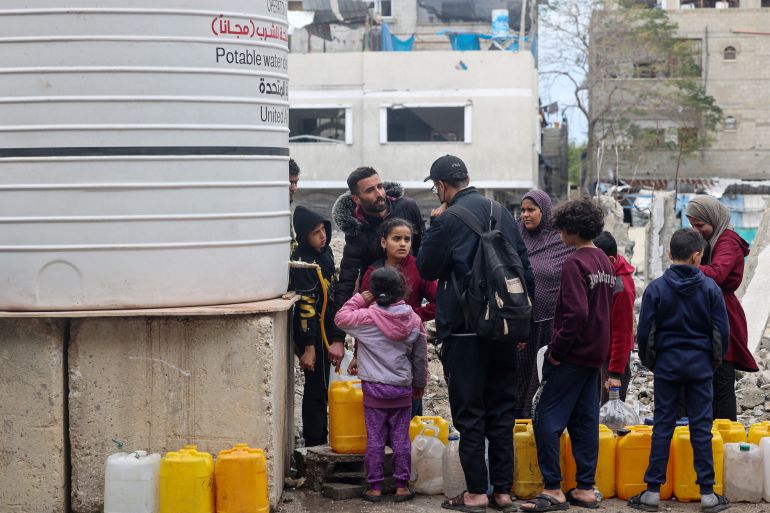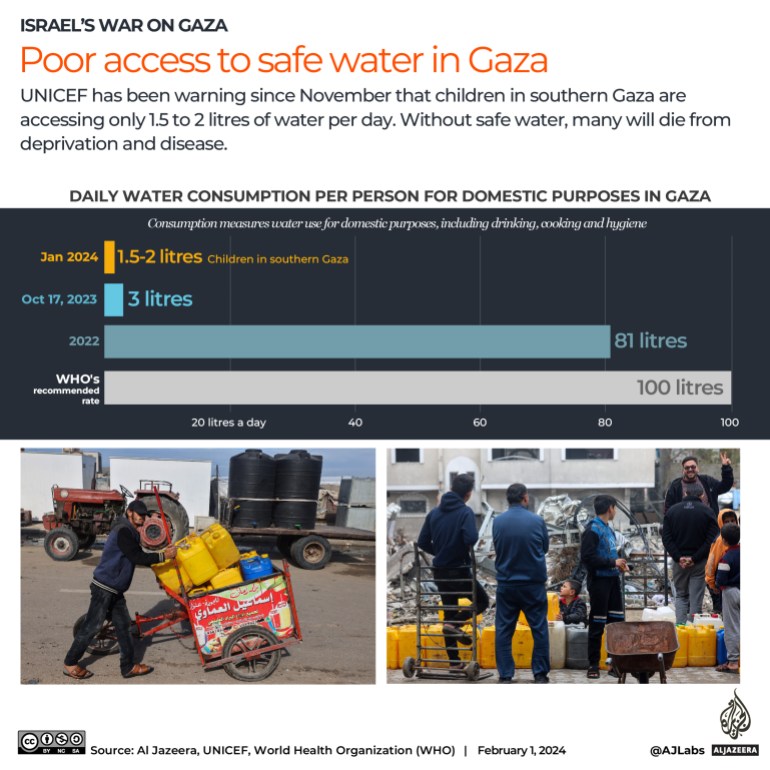How Israel’s flooding of Gaza’s tunnels will impact freshwater supply
Pumping of seawater will contaminate underground freshwater and ruin the conditions of life in Gaza, experts say.

Israel confirmed this week that its troops are pumping seawater into a network of tunnels in Gaza, a method environmentalists say could violate international law and cause dire, long-term consequences in the besieged Palestinian enclave.
Media reports have for weeks speculated that the pumping was under way, though Israeli and US officials, including President Joe Biden, did not confirm them when questioned.
Keep reading
list of 4 itemsWill it be safe for Palestinians in Gaza to return and rebuild their homes?
Palestinian President Abbas says only US can halt Israel’s attack on Rafah
Protesters heckle White House correspondents’ dinner guests
But on Wednesday, in a short statement on X, the Israeli military said it is using “new capabilities” in its war on Gaza and on Hamas’s labyrinth of tunnels, “including by channeling large volumes of water into them”.
The IDF has implemented new capabilities during the war, with the aim of neutralizing underground terrorist infrastructure, including by channeling large volumes of water into them.
This method was developed in cooperation with the @Israel_MOD, and is only utilized in locations…
— Israel Defense Forces (@IDF) January 30, 2024
“This is a significant tool in combating the threat of Hamas’s underground terrorist infrastructure,” the statement said.
The confirmation came nearly four months into the continuous bombardment of the strip that has killed nearly 27,000 people. Israeli authorities have for long aimed to destroy Hamas’s infrastructure, and have argued that the tunnels hold ammunition and captives taken there by the armed group on October 7.
But the plan to pump seawater into the tunnels raises questions about Israel’s plans to rescue those captives, and could add to the lasting devastation of Gaza, including the enclave’s water supply:
How is the flooding done?
Media reports from early December said that Israeli forces were planning to flood tunnels with seawater in Gaza using about five to seven large water pumps.
According to The Wall Street Journal, the Israeli army installed the pumps north of the Shati refugee camp, a beach settlement that housed previously displaced Palestinians located in the northern Gaza Strip. The machines, the report said, could pump thousands of cubic metres of seawater.
By mid-December, the WSJ, quoting unnamed US officials, reported again that the pumping had begun. Another US-based media publication, ABC News, reported that the scale of initial flooding was limited as the Israeli army assessed how effective the method was.
Hamas, which claims its tunnels run for about 300-500km (186-310 miles), has used the underground passage to break the Israeli siege on Gaza. Palestinians use the network of tunnels to smuggle food, goods, medicines and even weapons. The Palestinian territory has been under Israeli air, land and sea blockade since 2007 and Tel Aviv decides what goes in and out of the narrow strip that is 10km (6 miles) wide and 41km (25 miles) long.
The pumping could take weeks and thousands of cubic metres of water to completely fill and destroy such a network.

Could flooding the tunnels affect Gaza’s water supply?
Environmental analysts warn that flooding the tunnels could damage the aquifer that holds Gaza’s groundwater which the strip’s 2.3 million people largely depend on.
Mark Zeitoun, a professor at the Geneva Graduate Institute, told Al Jazeera that pumping seawater into hundreds of kilometres of tunnels embedded in Gaza’s sandy and porous soil is highly likely to see saltwater seep into water sources, destroying water that’s usually used for drinking, cooking and irrigation.
Zeitoun, who once worked as a water engineer in Gaza and the occupied West Bank, said Israel is weaponising water in a “dark” way. The engineer is among many who have been warning since December that there could be “catastrophic” consequences, should the Israeli military’s plans be confirmed.
“My first reaction was profound distress,” Zeitoun said, referring to the Israeli army’s Wednesday statement. “Injecting saltwater will definitely contaminate the aquifer and this will have long-term consequences,” he said.
“It would ruin the conditions of life in Gaza. If we don’t react to this kind of behaviour, what’s to stop any other country from doing this to another group of people in the future?”

What water risks do Palestinians already face?
Water infrastructure in Gaza and the West Bank has long been fragile. Israel’s Defence Minister Yoav Gallant ordered a “total blockade” of Gaza, including a ban on food and water on October 9 as part of its military offensive.
For decades, Israel has controlled water supply to the occupied territories, cutting off or turning it on at will. Palestinians in the occupied West Bank are not allowed to construct new water wells or any water installations without obtaining a licence from the Israeli authorities – which is often hard to do. Even rainwater collection is monitored in the West Bank. Moreover, Israeli soldiers and settlers attack infrastructure supplying water to Palestinians.
Hemmed in by an Israeli wall to its east and the sea to its west, getting useable water for drinking, cooking and hygiene in the Gaza Strip has always been even more complicated. Residents there rely on a combination of three seawater desalination plants, three pipes running directly from Israel, a host of wells and boreholes pulling untreated water from the ground, and imported water packs from Egypt. In a pre-war setting, those resources were barely enough for the densely populated region.
Adding to the problems is sewage contamination. Gaza’s authorities usually use about four wastewater treatment plants to keep groundwater from mixing with the sewers. Even then, an Amnesty International report in 2017 declared the aquifer overexploited and said 95 percent of the water supply in the strip was contaminated with sewage.
Since October 7 though, sewage has become unmanageable, spilling into the streets. Water scarcity too, has worsened. At least two of the desalination plants have shut down, damaged from Israeli shelling. Israel has also cut off some of the water from its pipes, and many of the boreholes no longer work because of a lack of fuel and electricity to pump.
Gaza, one of the most climate-vulnerable regions in a polluted and warming world, has been exposed to even more toxins, sais Amali Tower, director of non-profit Climate Refugees.
“Tens of thousands of unrecovered bodies are decomposing under rubble,” Tower said. “Thousands of explosives from the current and previous wars have polluted the air and ground, including highly incendiary white phosphorus, leaving another toxic layer of chemicals in Gaza’s air and soil.”
What’s next for Gaza’s water security?
Although water has been used as a tool in many conflicts, including in the Russia-Ukraine war, the case in Gaza is an exception, said Zeitoun, and violates multiple international laws, including possibly the UN Genocide Convention.
The law criminalises intentional actions inflicting conditions of life calculated to bring about the physical destruction, in whole or part, of a distinct ethnic group like the Palestinians.
“What we see happening in Gaza is beyond the pale,” Zeitoun said. “With the definition of the Genocide Convention in mind, I think salinating the aquifer, which is the main source of water, will bring about its partial destruction. Part of it could collapse and become unusable.”
Just last week, the International Court of Justice ruling in South Africa’s landmark genocide case against Israel, ordered Tel Aviv to take all measures to prevent genocidal acts – but there have been little to no changes in Israeli military’s scorched-earth tactics in the strip.
Meanwhile, nearly two million Palestinians in Gaza are being forced to drink brackish, untreated water. Women are taking pills to delay their menstruation due to lack of water and sanitary pads.
Waterborne diseases too, are skyrocketing. The number of Palestinians in Gaza suffering from dysentery multiplied 25 times between mid-October and December, with more than 100,000 cases recorded, according to the World Health Organisation (WHO). Children make up half of the cases since toddlers are more susceptible to a disease that causes extreme dehydration and, possibly, death.